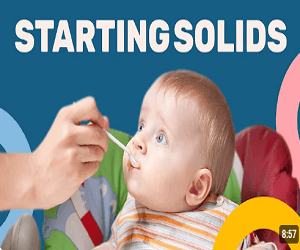A Comprehensive Guide to Starting Your Baby on Solid Foods
Knowing When Your Baby Is Ready
Starting solids is an exciting milestone in your baby’s development, but it’s important to ensure they are truly ready before introducing any new foods. The American Academy of Pediatrics and the World Health Organization recommend waiting until around 6 months of age when your baby shows signs of readiness.
Some key signs that your baby is ready to start solids include:
- Able to sit upright with support and hold their head steady for the duration of a meal
- Showing interest in food by watching intently as you eat, reaching for food, and opening your mouth when food approaches
- Reduced tongue thrust reflex, allowing food to stay in their mouth and be swallowed
It’s important not to start solids before 4 months of age, as your baby’s digestive system may not be mature enough to handle solid foods, and there is an increased risk of allergies. Breast milk or formula should remain the primary source of nutrition until around 6 months.
Choosing a Feeding Method
Once your baby is showing signs of readiness, you’ll need to decide on the feeding method you want to use. There are three main approaches:
Baby-Led Weaning (BLW)
With BLW, you offer your baby large, soft, finger-food-sized pieces of food from the very beginning, allowing them to self-feed and explore the textures and tastes independently. This approach bypasses purees and mashed foods.
Spoon-Feeding
The more traditional spoon-feeding method involves you, the parent, controlling the feeding process. You’ll start with purees and mashed foods, gradually transitioning to thicker textures as your baby gains skills.
Combination Approach
As the name suggests, this approach combines elements of both baby-led weaning and spoon-feeding. You may start with some purees or mashed foods while also offering soft, finger-food-sized pieces for your baby to explore.
There is an ongoing debate between advocates of these different methods, but all are considered appropriate. The most important thing is to choose the approach that you feel most comfortable with and that works best for your family.
Gathering the Essentials
Before you begin introducing solids, you’ll want to have the right equipment on hand to make the process easier and minimize the mess. Some key items include:
High Chair
A high chair is essential, as it allows your baby to sit upright and see you eating, which helps with modeling and safety. Avoid holding your baby on your lap, as this can make it difficult to monitor cues and safety.
Open Cup
Offer your baby a small, unbreakable open cup to encourage the development of drinking skills. Avoid sippy cups, as they can interfere with the transition to a regular cup.
Bowls, Plates, and Utensils
Choose bowls and plates with rimmed edges to help contain the mess. For utensils, select small spoons with smooth edges and shallow bowls, made of silicone or another soft material to prevent injury from biting down.
Minimizing the Mess
Introducing solids can be a messy process, but there are some strategies to help keep things a little cleaner:
Splash Mats and Bibs
Invest in a splash mat to go under the high chair, and choose bibs or smocks that cover your baby’s entire torso to catch drips and spills. Look for bibs with Velcro closures, which are easier to remove without pulling food across your baby’s face.
Washcloths and Gentle Cleaning
Keep plenty of soft, clean washcloths on hand, but avoid constantly wiping your baby’s face during the meal. Instead, use firm, gentle strokes to clean up after the meal is finished. Resist the urge to constantly scrape your baby’s chin, as this can be irritating.
Starting the Solids Journey
When you’re ready to begin introducing solids, start with just one teaspoon of food per day, offered after a milk feeding or at a separate time. Choose a calm, quiet time of day when your baby is relaxed, and minimize distractions by turning off TVs and devices.
It’s important to let your baby set the pace and not force them to eat more than they want. Babies are very in tune with their own hunger and fullness cues, so follow their lead. If they turn away or show disinterest, stop the feeding. Remember, learning to eat is a process, and your baby’s appetite will vary from meal to meal and day to day.
As long as your baby is growing and developing well, they are likely getting enough nutrition, even if they don’t seem to be eating a lot at first. The key is to make the experience positive and enjoyable, setting the foundation for a lifelong love of food.
By following these guidelines and being responsive to your baby’s cues, you can navigate the exciting journey of introducing solids with confidence and ease. Remember, every baby is different, so be patient, and flexible, and have fun exploring new flavors and textures together!
